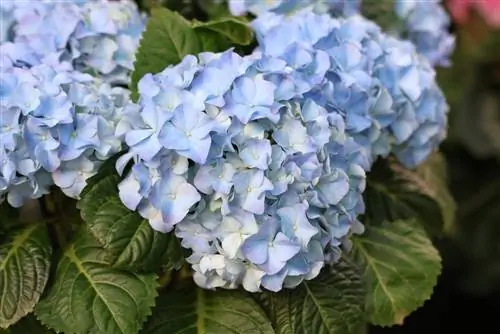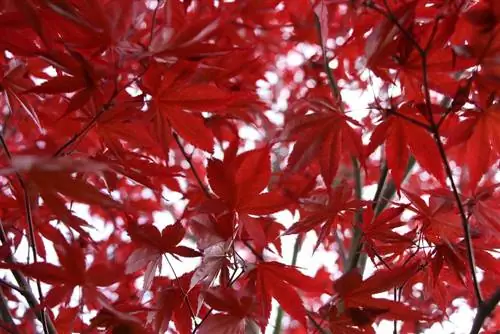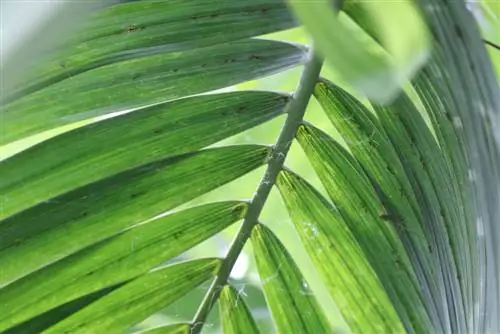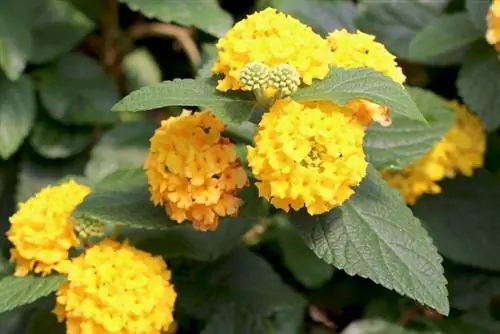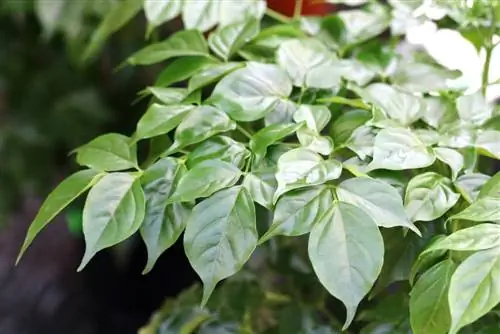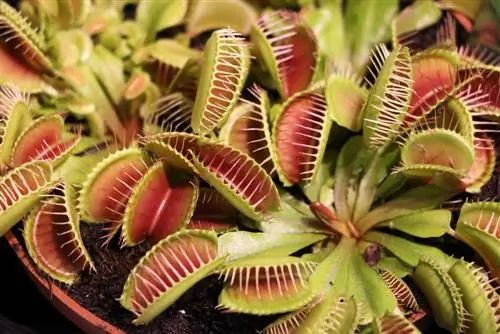- Author admin [email protected].
- Public 2023-12-17 03:39.
- Last modified 2025-06-01 06:48.
Hydrangeas with their magnificent flowers are a real feast for the eyes in the garden. The popular shrubs can also be cultivated in a pot on the balcony or terrace. You can find out how to care for the colorful hydrangea in this article!
Profile
- Latin name: Hydrangea
- Order: Cornales
- Family: Hydrangea family (Hydrangeaceae)
- Genus: Hydrangeas
- Flowering period: June to August/September
- Flower color: white, red, blue, pink, violet
- Growth height: up to 2m
Location
In the wild, around 60 species of hydrangeas grow primarily in Europe and Asia. There they are preferably found along watercourses and moist forest edges. But the plant feels at home in the garden or on the terrace or balcony - as long as the location has the appropriate conditions. Most hydrangeas prefer a spot in partial shade and enjoy sun in the morning and afternoon. However, some varieties also cope well with shade, such as farmers' hydrangeas and climbing hydrangeas. In general, the location should also have the following characteristics:
- sheltered from the wind
- sufficient distance from other shallow-rooted animals
- Balcony with western or eastern orientation
- protect from direct midday sun
Soil / Substrate
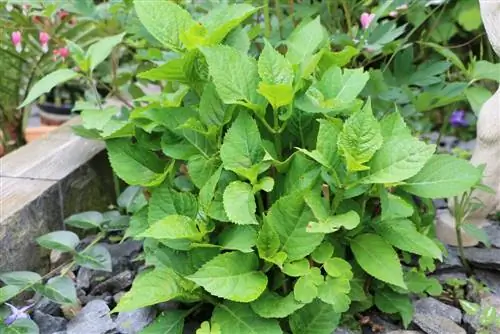
In terms of substrate, the hydrangea definitely has its requirements, as it thrives best in fresh and deep soil. The soil should also be very nutritious, as the plant has a very high nutrient requirement. However, if the existing substrate does not meet the optimal requirements, it can be improved with compost. The following substrates are suitable for hydrangeas:
- Mixture of peat and compost soil
- Hydrangea Soil
- Rhododendron Soil
- Azalea soil
- expanded clay
Pots / Buckets
Hydrangeas can also be easily grown in a pot on the balcony or terrace. It is important to ensure that the pot size corresponds to the size of the plant. Pots that are too large are not only unwieldy, but also take up unnecessary space. The containers should also have drainage holes so that excess irrigation water can drain away. Although hydrangeas like a moist substrate, they cannot tolerate waterlogging.
Sowing
Hydrangeas in this country are usually sold in containers or as bare-root specimens. Germinable seeds, however, are rarely available. Obtaining seeds also turns out to be difficult because many new varieties no longer produce seeds. Propagation using cuttings is generally recommended. If you still want to try your luck with sowing, it's best to proceed as follows:
- fill small containers with potting soil
- Spread seeds in it
- add a very thin layer of soil over it
- Carefully moisten the soil
- Cover container with plastic wrap
- Remove the film in between to prevent rot
Note:
The small containers are best watered with a sprayer so that the seeds are not washed away.
Pricking out and hardening off
It can take a while for the seeds to germinate. As soon as the small plants have reached a height of around 10 centimeters, they are pricked out and placed in their own pots. However, the plants should under no circumstances be left outdoors as they are still very sensitive. It is better to continue caring for them in a warm, protected place. The hydrangeas should remain indoors for the first winter, although the location should be as cool as possible. A good place for the first winter is, for example, a stairwell or a basement room. Only from the second year can the hydrangeas slowly get used to the outdoors:
- Keep putting the plant outside for a short time
- Avoid the blazing midday sun
- protect from rain and wind
Planting
Before the hydrangeas are planted, they should first be provided with plenty of water. For container plants, it is usually sufficient to immerse the root ball in a bucket of water and wait until no more air bubbles appear. For bare-root specimens, however, it is advisable to soak the plants in water for around two hours. This allows the roots to soak up water and are therefore ideally prepared for planting.
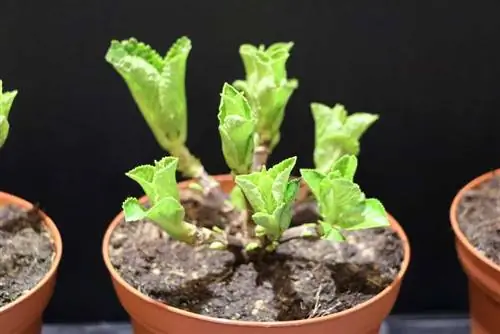
Planting itself is easy and is as follows:
- dig up a sufficiently large planting hole
- Loose the soil
- Place the plant so that the root ball is at ground level
- Fill the planting hole with soil
- Tamp the substrate firmly
- water thoroughly
Note:
The root system should always be checked before inserting. If some roots are spiraling on the wall of the pot, they should be removed. Otherwise the growth of the shrub would be hindered.
Support
A support is not a must for hydrangeas, but is still recommended for some varieties. These primarily include hydrangeas that form large inflorescences, such as snowball hydrangeas (Hydrangea arborescens) and farmer's hydrangea (Hydrangea macrophylla). Various utensils can be used as support, all of which have their advantages and disadvantages. Bamboo sticks, for example, can be used to support many individual branches, but they can look unsightly. That's why many hobby gardeners use the following supports:
- Perennial rings: circular | good for smaller plants
- Perennial holder: semicircular | good for larger plants
Fertilize
Hortensas are heavy feeders and have a correspondingly high nutrient requirement. Unfortunately, nutritious soil is not enough, which is why the plants need additional fertilization. Both a special hydrangea and a conventional rhododendron fertilizer are suitable for this. These fertilizers not only provide the plant with important nutrients, but also ensure persistently acidic soil. Alternatively, there are also cattle dung pellets, which are incorporated into the upper soil layer in spring or autumn. In general, however, fertilizing hydrangeas is manageable:
- Fertilize until the end of July
- Shoots ripen until late summer/autumn
- develop good frost hardiness
Note:
Fertilizers rich in phosphates, such as blue grain, are not suitable for hydrangeas. Because they inhibit the absorption of aluminum s alts and thus prevent the flowers from turning blue.
Pouring
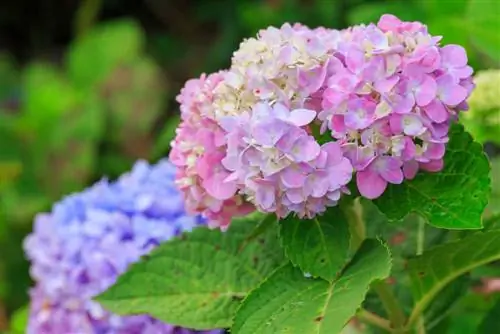
The hydrangea lives up to its botanical name “Hydrangea” (water slurper), because it is very thirsty and therefore needs to be watered often and regularly. The plant prefers a substrate that is always moist, but should neither be too wet nor too dry. It may therefore be necessary to water hydrangeas several times a day, especially on hot summer days. For specimens cultivated in pots, water reservoirs that release water slowly and continuously are ideal. When watering, you should also pay attention to the following points:
- It's best to water with rainwater
- softened drinking water is also suitable
- Tap water, on the other hand, is too calcareous
- Avoid waterlogging at all costs!
Note:
If hydrangeas let their leaves droop at midday in summer, they should definitely be watered more!
Cutting
With regard to cutting, no general statement can be made for hydrangeas, as this depends on the respective species. Country, velvet and plate hydrangeas produce their buds in the previous year and should under no circumstances be cut back in spring, otherwise flowering will be prevented. These species are usually only thinned out and freed from frozen and dry branches. For this purpose, the inflorescences are best cut above the bud. Ball and panicle hydrangeas, on the other hand, bloom on new wood and can be cut back as follows:
- prune in late fall or winter
- on one pair of eyes per branch
Note:
If you are not sure whether to cut or not, it is best to check the plant after winter. If it has buds, it should not be cut.
Wintering
Hortensas cope with local winters quite well, but frost and long-term sub-zero temperatures can cause problems for them. It is therefore advisable to protect the plants from frost accordingly. In general, it is advisable to add a layer of leaves in the root area, which is then covered with pine twigs. If temperatures fall below 5 degrees Celsius and/or the hydrangeas have been newly planted, they should be provided with additional protection. In this case, covering with a fleece hood is recommended. Additionally, pay attention to the following when wintering:
- Potted plants can overwinter indoors
- at around 5 - 8 degrees Celsius
- cut out frozen branches in spring
Note:
Farmer's hydrangeas are particularly susceptible to severe cold frosts because they form their buds the previous year. If they are not adequately protected, the buds will freeze and the flowers will fail in spring.
Propagation

The propagation of hydrangeas is best achieved using green cuttings that are taken from the mother plant in early summer. For this purpose, young shoots without buds are cut off in July and then divided into individual pieces. These should each have a pair of leaves at the top and bottom. With these pieces, hydrangeas can usually be reliably propagated as follows:
- Fill the container with potting soil
- insert lower end into rooting powder
- promotes the formation of the plant
- Place cuttings in potting soil
- pour carefully
- Cover container with plastic wrap
Pests and diseases
The pretty hydrangeas are a real feast for the eyes, not just for hobby gardeners, because they also attract numerous pests. The plants are often attacked by aphids and scale insects as well as black weevils, red spider mites and blind bugs. Diseases can also affect hydrangeas, with them being particularly susceptible to gray mold, hydrangea virus, leaf spots and mildew.
Care errors
When hobby gardeners wait with joy for the hydrangeas to bloom, but they don't appear, they are often disappointed. It is not uncommon for the plants not to produce flowers. However, this can usually be attributed to care errors and can therefore be avoided. If flowering fails to occur, the following reasons could be responsible:
- pruning too much
- too much sun
- unbalanced fertilizer
- wrong wintering/insufficient frost protection

